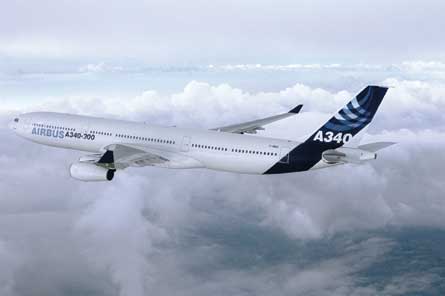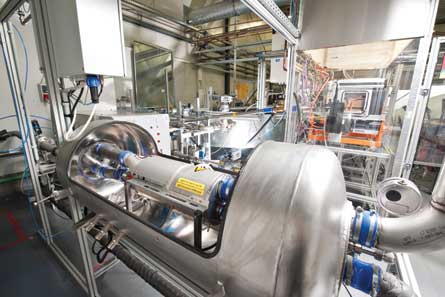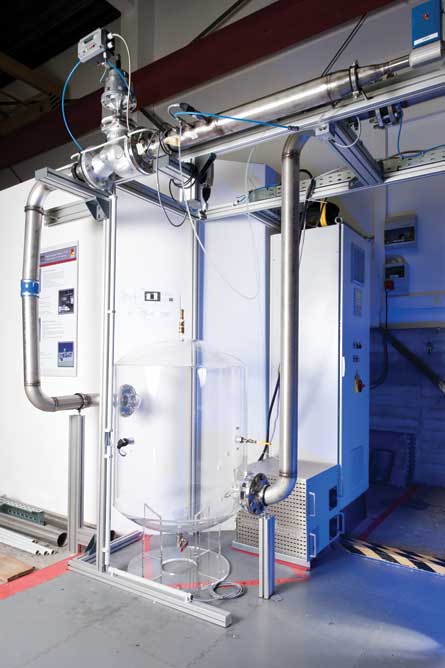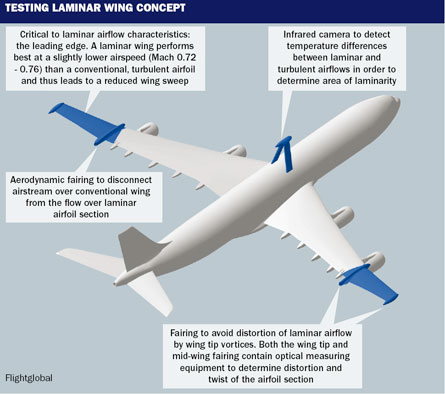Development of a laminar flow wing that aims to cut fuel burn and carbon dioxide emissions by up to 6% on the next generation of narrowbodies is progressing steadily. The wing is being billed as having the potential to offer one of the most significant downward impacts on fuel burn of any one technology.
Airbus, along with Saab Group, Dassault and the Fraunhofer research institute, is working on a laminar flow wing demonstrator, which is to be flight-tested on an A340 in 2014 and which should lead to a production wing design for a next-generation short- to medium-range aircraft.
The project is part of the European Union's Clean Sky initiative and one of the main integrated technology demonstrators (ITD) for the €393 million ($550 million) "Smart Fixed-Wing Aircraft" research and technology effort. Airbus is leading the development, manufacture and testing of the laminar flow wing demonstrator together with Saab. The project began in mid-2008 and is scheduled to end in 2015. Rather than inventing concepts, the Clean Sky objective is to mature and accelerate technologies which have emerged from previous R&T projects as the most promising candidates for a step change in efficiency.
"We want to gain all the remaining information, which is still open, to become confident that the technologies will be working reliably and that we can apply them in a real industrial environment later on," Jens Koenig, co-ordinator of Airbus R&T in Clean Sky, says.
 |
|---|
The entire wing section of an A340-300 will be replaced by a fully functional section of a laminar flow wing |
This means the laminar wing will not only lead to a reduction in fuel burn, but also perform at least as well as current generation equipment in terms of reasonable manufacturing costs at high production rates, aircraft dispatch reliability as well as maintenance costs and time requirements during its full product cycle.
The research partners plan to replace the entire existing wing section of an Airbus-owned A340-300 (MSN001) - between the outboard engine and wing tip on both sides - with a fully functional section of a laminar flow wing. The two, approximately 8m-span (26ft) airfoils will have the same geometry but be constructed differently to evaluate two distinct manufacturing concepts.
While the section for the left wing will be made using individual structural components and surface panels similar to a conventional wing, its right-hand counterpart will have a carbon-fibre reinforced plastic upper wing surface with integrated D-nose.
In other words, the airstream will flow across a seamless surface from the leading edge to aft end of the upper wing area, just before the ailerons. Joints, gaps, steps and rivets and bolts need to be avoided because they disturb the laminar flow and cause transition to a turbulent airstream. As the wing surface needs to be extremely smooth, an integrated design lends itself to a laminar wing rather than a construction with individual parts.
However, the high complexity of the combined D-nose and wing surface panel requires not only higher precision and tighter manufacturing tolerances, but also leads to higher production costs than for individual parts.
Integrating the D-nose with the upper wing surface is the main advantage of using composites and will not be possible with metal sheets, according to Koenig. However, whether the single integrated component can be extended to the full span of a future wing has yet to be determined, he added.
For the other wing section, which will comprise individual surface parts, metal may remain the central construction material.
"We are not sure whether the wing will be based on a metal or composite structure. In particular, the leading edge and upper cover panel are critical with respect to the structural design concept, surface features such as quality and tolerances, and the bonding to the prime structure and other parts of the wing," Koenig says.
Saab is primarily responsible for designing and manufacturing the integrated wing section. Aside from the surface and D-nose, the panel includes structural components such as stringers, rib feeds and spar caps.
The latter two are required to attach the surface to the wing ribs and front and rear spars internally to avoid exterior fasteners. The Swedish company produced a 2m² test panel at the end of last year, which represents about 25% of the final wing structure, to check its construction technique and tooling. The team used pre-impregnated carbon fibre material to build up the component, including all internal structural elements, and then cured the entire layup in a single autoclave cycle.
Thomas Hellstrom, project manager for smart fixed-wing aircraft at Saab and ITD co-leader, says the team had achieved "very good" surface qualities and tolerances on the internal parts. The next big step is to upscale the production for the full-size wing structure which involves, for example, designing a new tool for the composite layup. "Thus far we have not discovered any show stoppers," he adds.
|
|---|
A main aerodynamic bugbear, aside from determining the wing's shape and achieving a smooth surface, is to avoid waviness. A conventional wing's surface can bend and buckle both span- and chord-wise under loading. Also the airframe structure can leave an 'imprint' of the attachment points on thin, lightweight skin panels and thus change the airfoil profile. A laminar airflow, however, can only tolerate a "very small" amount of waviness, according to Koenig. The challenge will be to build a wing that keeps these oscillations to a minimum across the entire area of laminarity in all flight conditions, and yet be more lightweight than today's equipment.
While current wing designs achieve laminar airflows up to around 5% of chord width under optimal circumstances, the engineers want to extend this area to approximately 60% depending on the flight conditions.
"With current technologies, we don't see any possibility to stretch the area of laminarity any further than 60% given the requirements of an A320-type airliner," says Koenig.
The target is to reduce the drag of the wing by up to 25% in cruise flight, which would translate to a total aircraft drag reduction between 5% and 6%. "There are little [other] chances aerodynamically to have such a big gain with just one technology," he adds.
In the next two and a half years, the R&T partners will conduct ground tests with life-sized and scaled feature demonstrators of the airfoil or individual segments of it before the final wing can be built and flight tests begin in the second quarter of 2014. Bird strike is a typical test point that is particularly relevant for the integrated surface panel. Much effort will go into finding ways to accommodate aircraft systems such as wing ice and lightning protection equipment in the airfoil, as it will have a different shape and structure to a conventional design. For example, the nose radius will be smaller and the largest camber further downstream than on current wings.
Another central area for evaluation will be surface coatings. Dirt and insects are main enemies for the laminar airflow. At slow speed, contamination will be prevented via a Krüger flap which, aside from serving as a high lift device, should shield the leading edge from foreign objects. At high speed, however, the surface coating will be the main protection to keep the wing aerodynamically - and literally - clean. The substances, which can not only provide anti-contamination properties but also withstand erosion, for example during hail storms, are still in development, Koenig says.
If the CleanSky smart fixed-wing aircraft project feeds into a future production programme, as intended, the new wing is most likely be for a successor to the A320-family. "In principle, laminarity is providing us with an optimum travelling speed, which is slightly below what we need for long-range aircraft. So the target is absolutely the short- and medium-range class of aircraft, because the trip length as well as required speeds are pretty much playing in the same direction as the technology," Koenig says.
Airbus has regularly pushed back the development of a next-generation, single-aisle aircraft and now predicts - after the A320neo programme's launch - that a clean-sheet successor will not arrive before 2030. The airframer has largely blamed the unavailability of new powerplants for the later arrival.
"We have now a bit more time which is very good for us, because there are still a lot of challenges in the development of the technology. In the end, we are happy that the timeframe is not as close as it was before," Koenig says.
This indicates the decision to re-engine the A320 has pushed the production of an all-new aircraft further back, and that the long-term sales record of the updated twinjet - as well as its competitors, including a potential new aircraft from Boeing - will determine when Airbus has to bid farewell to the existing generation. When the new aircraft arrives, today's R&T work could be a stepping stone for the Swedish project partner to grow its participation in the European aircraft programme. Hellstrom says that "from Saab's perspective, we are, of course, hoping that it will be included in a [A320] successor".
AIRBUS PARTNERS PARKER AEROSPACE TO DEVELOP HYDROGEN-BASED APU
Airbus has partnered Parker Aerospace to develop a hydrogen-based replacement system for the auxiliary power unit, which could find its first application on the projected next-generation single-aisle aircraft beyond 2020.
The agreement will add to the airframer's previous research into fuel cell technology and build a technology demonstrator to be flight-tested in 2015. The plan is to offer this to a new aircraft development team at "technology readiness level 6 (TR6)" about one year later, Axel Krein, Airbus senior vice-president research and technology, says. Unlike current APUs, the new system will not only generate electricity and, if still needed, bleed air but also portable water and oxygen-depleted air (inert gas) as by-products of the chemical reaction between hydrogen, which will come from a fuel tank, and oxygen in the ambient air.
While the water can be fed into the aircraft's freshwater system, the inert gas could be used for the fire suppression equipment in the main fuel tanks and cargo compartments, for which bottled gas is currently used. The fuel cell solution would therefore lead to a fundamental change in system architecture and rule out a retrofit option for existing models, including the forthcoming Airbus A350 and A320neo. A first application could be on the projected narrowbody successor A30X, Krein says. Airbus has progressively pushed the arrival of that generation back, currently forecasting service entry around 2030.
 |
|---|
Airbus and Parker Aerospace are working to create a hydrogen-based replacement for the auxilary power unit. |
The challenge is to optimise the aircraft's overall architecture for the new system. The fuel cell technology should deliver a fuel burn reduction on a standard short- to medium-haul mission of 10-15%, Krein says.
However, the overall benefit would depend on how cost-effectively the hydrogen system can be introduced to aircraft and ground operations. Reducing the fuel cell system's weight and maintenance costs will be important. Weight will be helped by the reduced need to take fresh water onboard at the airport. Engineers will need to determine the amount of reduction or the possibility of producing all fresh water with the fuel cells.
 |
|---|
Airbus senior vice-president of research and technology Axel Krein said the new fuel cell technology should provide a 10-15% fuel burn reduction on a standard short- to medium-haul mission. |
Krein says while it is possible to build a fuel cell prototype at the targeted weight, this would come at a high cost and would not be feasible for serial production. He adds that competitive maintenance costs will be another challenge given the increased complexity of the new system and the fact support for conventional equipment has become virtually automated.
While Parker will supply the fuel cell system and manage different sub-system suppliers, Airbus will be responsible for the overall aircraft system architecture. Krein says the fuel cell could also be used to power electric motors to move the aircraft on the ground.
Source: Flight International

















